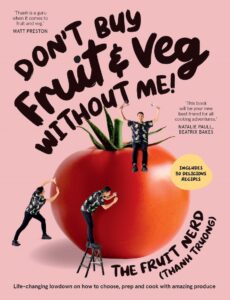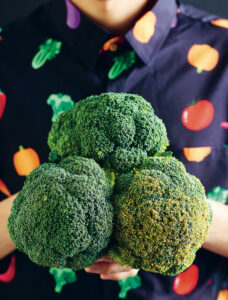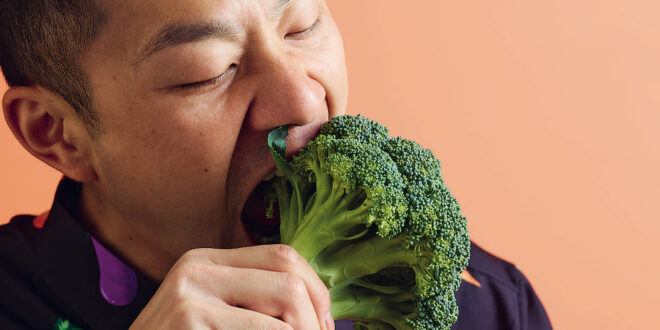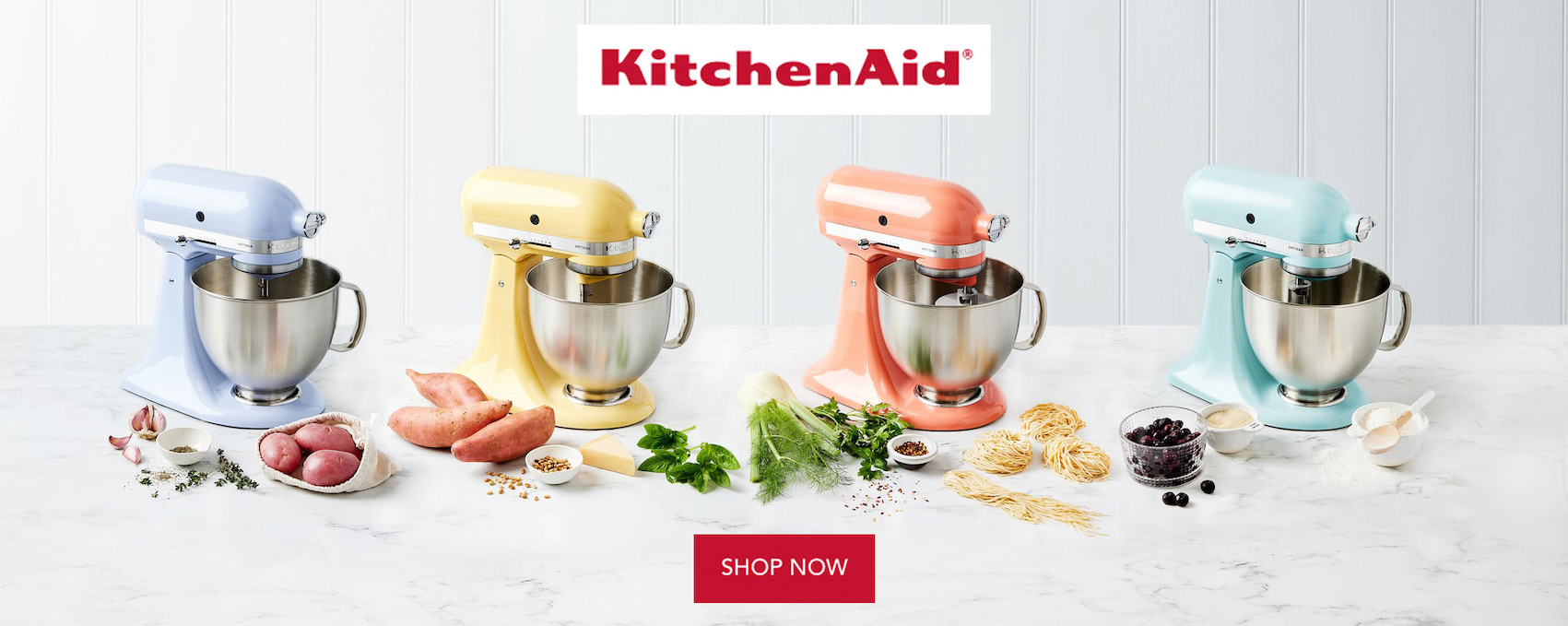 Extracted from Don’t Buy Fruit and Vege Without Me by Thanh Truong, Macmillan Publishers, RRP $44.99
Extracted from Don’t Buy Fruit and Vege Without Me by Thanh Truong, Macmillan Publishers, RRP $44.99
Is there a more humble green vegetable than broccoli? I would argue not. Broccoli is so easy to eat that it is the hero vegetable for fruiterers and parents alike. Nearly everyone is comfortable cooking broccoli, and nearly everyone enjoys its flavour. Only the pickiest eaters despise broccoli. Most of us boil it for a few minutes and have it on our plates for dinner, but how often do you see broccoli served in a fine-dining restaurant? Probably rarely, maybe never. Think about it. I rest my case – broccoli is the most humble of all vegetables in the Western world.
Broccoli is a universally loved vegetable. It even has its own emoji – that’s when you know you’ve hit peak vegetable love.
Amazing Broccoli
There are moments in every industry when your sector hits the news, and for all the wrong reasons. In the winter of 2022, Australian vegetable prices hit peak inflation, with lettuce creeping above $10 a piece. I filmed an ABC News explainer about why produce was so expensive and I pleaded with Aussies to look at other good-value produce that was in season, specifically brassicas.
Vegetables aren’t the most glamorous subject to make the news, and so when ’veg’ hit the headlines it gave the industry a chance to champion other vegetables, such as broccoli. That year the Melbourne winter was cold, wet, foggy and frosty. Local vegetable growers were saying that the cold snap had helped certain vegetables and that they were ’eating well’, but none spoke about the technical reasons why. If freezing air temperatures last long enough, most vegetables growing in the ground are damaged or perish, but not brassicas and especially not broccoli.
You see, produce is amazing and creates all sorts of natural adaptions and defences against the elements, namely frost, which is when the temperature drops below freezing, or 0°C. Broccoli plants respond to frost by releasing enzymes called amalyse, which break down the starches in broccoli and turn them into sugars, and this lowers the freezing point of the plant. Broccoli can survive if the temperature doesn’t drop below -3°C. Not only is this an incredible defence mechanism, but it also makes the broccoli sweeter. This magical mechanism can be found in many crucifers or brassicas, including cauliflower, kale and brussel sprouts. Why would we worry about the price of lettuce when broccoli and other brassicas weren’t only good value, but arguably the best-tasting they could be?
I detest the term ’in season’ because it’s somewhat meaningless in the modern food system that ensures year-round supply of vegetables such as broccoli. If growers and fruiterers say winter vegetables are in season, we need to prove it; they need to taste better than when they’re out of season. Furthermore, we need to celebrate these reasons and not be fearful of giving buyers a minute-long explainer instead of using the vague term ’in season’.
A Scientific Explanation
While visiting Agriculture Victoria’s horticulture production science team at the AgriBio Centre at La Trobe University, I asked crop physiologist and research scientist Christine Frisina some of the burning questions I’ve always had about broccoli. Agriculture Victoria has performed research on all types of crops grown in the state for the benefit of growers, from examining production all the way to post-harvest management and storing the produce. Researchers like Christine are my heroes and the true fruit nerds of the world! I may be a communicator, but they are the real scientists who figure out the tips and technical reasons why produce tastes good or bad.
Broccoli can last for weeks in the fridge and is transported from farms to markets packed in ice. Christine says that a good broccoli should be dark green in colour; pale florets can suggest the produce has aged or been mismanaged on the farm. Christine also gave me her hack for storing broccoli in the fridge. She explained that broccoli shouldn’t be suffocated in a plastic bag, although it does need a humid environment so the florets don’t dehydrate. In order to achieve this without a commercial breathing bag, Christine places the broccoli in a plastic bag, ties it up and pokes her finger where the knot is to create a small air hole for the broccoli to breathe. Christine explains that if the broccoli can’t breathe, after several days it will start to generate an anaerobic response, where it uses carbon dioxide rather than oxygen to breathe, and develops strange flavours in order to survive. While temporary storage of broccoli for a day may not need a breathing hole, creating a hole is a far more conscious way to store and treat this ’still-alive’ brassica with the respect it deserves, so it tastes as great as it can!
Embracing Stalks
I love broccoli stalks, but I know why many people don’t. A lot of people are put off by the thick skin that develops at the base of a broccoli, which is often stringy and hard. Depending on the age of a broccoli, sometimes I remove the skin and cut the stalk into crunchy sticks to boil with the florets. I suggest generously cutting off the skin and only eating the internal part of the stalk if you’re not usually a fan. You can freeze the broccoli skin offcuts and use them in your next soup stock!
Ironically, broccolini is loved because of its crunchy and tender stalks. What you may not know is that broccolini is a trademarked seed, also known as a PBR (Plant Breeder’s Rights), where a company exclusively owns the rights to sell and market the vegetable. It is a variety bred from Chinese broccoli with regular broccoli traits. I recently discovered that before broccolini existed, local Italian vegetable growers used to cut the side shoots off a broccoli plant and fry them up. Anatomically, these side shoots didn’t have a thick skin and were loved because of their tender crunch. Broccolini almost exactly replicates this without being a side shoot of a plant and curly in shape; instead its stalks are straight and uniform. Choosing broccolini is easy because they are grown and harvested to be tender, hence they don’t have a long shelf life like broccoli.
On an interesting note, one of the first produce videos I ever created – which, funnily enough, was never watched – was out in Werribee, a key broccoli-growing region for Australia. I was told to pick the broccoli out of the ground and eat it raw, and it was arguably the sweetest broccoli I have ever eaten. There is something very primal about eating raw broccoli straight from the ground. Growers have told me that the natural raw sweetness disappears hours after picking broccoli from the field, yet they have never been able to explain why. So if you do grow broccoli in your backyard, pick it out of the ground on a cold winter’s morning and go for a bite – you’ll be sweetly surprised.
Thanh’s Tips

Choose
1. Look for dark-green produce with a firm stalk. Avoid yellow or pale-green broccoli, as this suggests it is aged stock.
2. Small beads on the broccoli head are best; large beads can be a sign that the broccoli was picked at a mature stage and close to flowering (meaning the broccoli won’t be as tender).
3. A cracked base won’t affect flavour, but it will affect shelf life (most fruiterers report dehydration and mould developing faster with cracked stalk bases).
Store
Store broccoli and broccolini in a plastic bag with a small hole, to allow the vegetable to breathe while keeping humidity high, in the coldest part of the fridge.










Join the Discussion
Type out your comment here:
You must be logged in to post a comment.